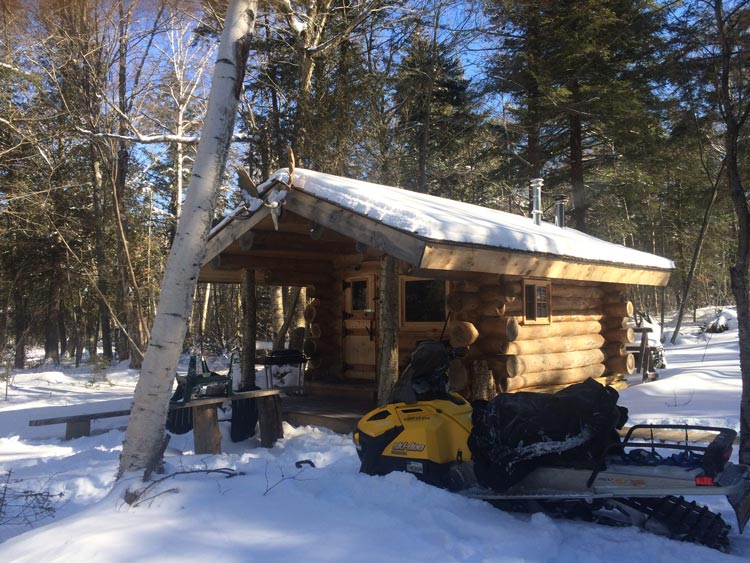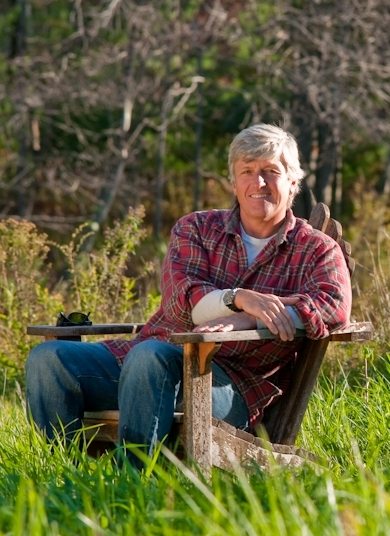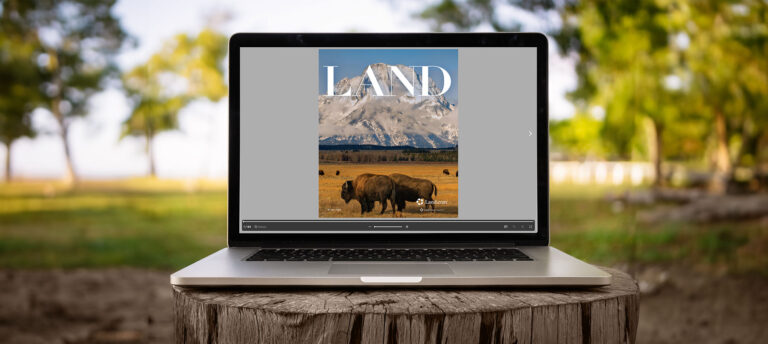Northern New York boasts some of the country’s best quality, hunting and fishing land offering both scenic beauty and affordability for people who are willing to look at land off grid. an amazing and perhaps unanticipated benefit of an off-grid cabin is the feeling of independence you enjoy from truly living off the land.
My love for the woods and camp life began when I was a teenager and I dreamed of someday living and working in the woods. After earning my degree in wildlife management and forestry, I landed several jobs in land acquisitions, forestry and guiding. My first position after college was as a hunting and fishing guide and forester at Bay Pond, the Rockefeller family’s estate in the Adirondacks Mountains. While at Bay Pond, I worked with several old timers and backwoodsmen. My favorite mentor, aptly named “Woody,” taught me some valuable lessons about back country living, or as he called it, “the ways of the woods.” During this time I learned to plant trees, build structures with logs and fell timber. Woody taught me how to make my own root cellar to store food and cold drinks. I also learned how to collect water in a cistern, instead of building a well, and I mastered the basics of harnessing and storing the sun’s energy for power, instead of relying on man-made electricity.
Many people want an off-grid camp, not so much for hunting and fishing, but as a retreat where they can unplug and get away from the stress and pressure of modern life. Many land customers also tell us that they appreciate having a place to go to feel fully independent.
By the time I was 25, I had learned how to truly provide for myself and my family and I dreamed of creating my own place in the woods. My first Adirondack camp was a simple, 12’x20’ log cabin, located 10 miles from power poles and pavement, along an old logging road in a boreal forest called “Kildare.” At Kildare, I first learned how to install heat, lights, running water and refrigeration in a camp that was way off the grid—something almost unheard of in the early 1980s.
Around this time, I also began creating a company that would specialize in helping families, sportsmen and everyday people, just like me, to build their own cabin in the woods. I wanted a land company that would make New York’s beautiful woodlands affordable to middle income people. For me this meant not only finding good quality land for folks, it also meant helping them set up their camps for comfortable back-country living. My land company would be committed to outstanding ethics while maintaining a great work atmosphere.
In 1988, I founded Christmas and Associates and began acquiring and selling land to hunters, fishermen and outdoorspeople. We also started building cabins for our land customers and we offered forestry, land use planning and brokerage services throughout New York’s Adirondacks, Tug Hill, and Southern Tier regions. Our philosophy has always been simple: offer the best customer service and the finest quality properties at the lowest prices. We offer a variety of recreational property including waterfront, large acreage tracts, hunting land and land and camp packages—all with our complete customer guarantees and in-house financing.
Since the beginning, Christmas and Associates has worked with many customers to set up their own small, self-sufficient camps. Helping people build a remote camp that is completely energy independent and comfortable is easy, affordable and rewarding. Our “land and camps” business model has worked for us in New York, Colorado and Montana—all locales where we have successfully sold land and camps to middle income Americans.
Many people want an off-grid camp, not so much for hunting and fishing, but as a retreat where they can unplug and get away from the stress and pressure of modern life. Many land customers also tell us that they appreciate having a place to go to feel fully independent. In America’s cities and suburbs today, people rely primarily on state, county and local governments for their resources—sharing limited services for fuel, heat and water while being tied to an increasingly antiquated electrical power grid system. At an off-grid camp, you rely solely on sunshine, rain and your own ingenuity!
Today, there are many ways to equip an off-grid camp. When considering which system will work best for you, the first step is determining your wattage needs. Electric devices require significant wattage and will increase demand, thus dramatically increasing the size of the system you will need. Propane fuel is an alternative option and can also be used to power a cooking stove, hot water heater and a refrigerator rather than electricity.
Gas refrigerators, for example, are handy for extended stays and prices run from $800 to $1,000. A propane cooking stove is also nice to have and tabletop models with two or four burners are available. Some even include a small oven. Or you can run electric for some devices and keep others on propane, depending on your needs.
People who spend weekends at camp, for example, may only need a basic source for hot and cold running water and a few lights. In this situation, a few solar panels or a mid-sized generator with battery backup, coupled with a mid-sized inverter, is all that’s required. Solar generators are easy to set up and are fairly inexpensive. With most off-grid systems, you incur initial set-up fees but then you can use the systems for up to 20 years without ever paying a utility bill!
If you decide to set up electric power, you will need three basic items including a source for generating energy, a method to convert energy and a way to store it. For example, solar panels are a common power source for our cabins. In upstate New York, sunny days are limited so we recommend our customers also install a generator to kick on when sunlight is not available and when your power storage is low. Batteries are set up on a meter so that when no electricity is being created, the generator starts automatically. This is our preferred solution but some people bypass the solar panels and simply buy a generator to keep the batteries full. Depending upon where your cabin is located in the U.S., you may also consider wind generators, water turbines or a motorized generator to create power.
To convert DC (direct current) power into AC (alternating current) power for regular, household-type electric use, you will need an inverter that is wall-mounted close to your batteries. The required inverter size depends on what devices you will use at camp and your frequency of use. For example, most seasonal camps operate adequately with an 850 to 1,000 watt generator. Components are wired together and the inverter has a wire that provides 110 household-type power to the camp panel box.
For power storage, we recommend using a battery system. We prefer gel batteries over the deep cycle type because they are maintenance-free and do not degrade as much when undercharged. Gel batteries also operate in below-freezing temperatures, which is ideal for weekend or seasonal camps in cold regions. The number of batteries you need is based on your usage and how much you want to hear a generator run or how often you add fuel to your generator. To protect gel batteries in winter, they require insulation and adequate ventilation. And although pricier initially, gel batteries tend to cost less to run per month and per cycle.
Once electricity is in place, you can install lights, water pumps and other electric devices. A water pump and an on-demand water heater are nice to have and will run $250 to $900, depending on the size you need. Also, to conserve energy, we suggest you use low wattage or LED lighting.

Another important consideration is heating your cabin. We prefer a woodstove but some folks prefer propane heaters. Propane heaters are also efficient to keep a camp heated when unoccupied to prevent water pipes from freezing. Two 100-pound propane tanks filled each spring should last a small cabin all season.
As for inside plumbing we always recommend pex piping, not copper, as it is less likely to freeze and break in frigid winter temperatures. We also build our seasonal camps with a hot and cold drain off the low end of the building. In that way, if you decide not to heat your camp in the winter, you simply shut off the well switch (if you have one) and open the two drain valves to drain the pipes to prevent freezing.
Many off-grid customers avoid digging a well and running water pipes. Instead they install rainwater collection systems or simply bring water from home. In many cases, nothing beats the price per gallon of rain water, making a rain barrel catchment system appealing. Rain barrels can only be used when temperatures are above freezing, though, so an alternative system is typically used in cold seasons.
Components, sizes and designs for all these systems can be adjusted for any size dwelling—from a simple wilderness camp to a larger, more elaborate cabin. As described above, the camps we build and help equip are completely functional for almost the same cost as two years of utility bills. With an off-grid cabin set-up, we believe you can enjoy all the necessary comforts of home and most of these systems offer a 10 to 20 year life expectancy.
Northern New York, where Christmas and Associates now sells land full time, boasts some of the country’s best quality, hunting and fishing land offering both scenic beauty and affordability for people who are willing to look at land off grid. And an amazing and perhaps unanticipated benefit of an off-grid cabin is the feeling of independence you enjoy from truly living off the land.
About the Adirondacks
Created in 1892 by the State of New York, the Adirondack Park is a constitutionally protected Forever Wild area. At 6 million acres, it is the largest publicly protected area in the contiguous United States. New York State owns approximately 2.6 million acres, while the remaining 3.4 million acres is privately owned and devoted to forestry, agriculture and open space recreation. The Adirondack Park is not a National Park—there’s no fee to enter and the park does not close at night, nor is it a state park, a common misconception. It is, however, the largest National Historic Landmark, covering an area larger than Yellowstone, Yosemite, Grand Canyon, Glacier and the Great Smokies National Parks combined. The Adirondack Region is located in northern New York, approximately four hours north of Manhattan and two hours south of Montreal. The region contains over 3,000 lakes and ponds and more than 30,000 miles of streams feeding 6,000 miles of rivers. The Adirondacks Mountains feature 46 “High Peaks” boasting an elevation over 4,000 feet. The High Peaks offer over 2,000 miles of designated hiking trails, providing access to spectacular mountain views. Visitors to the area enjoy almost every recreational activity imaginable—from boating and fishing to hiking and ice climbing to hunting and trapping.
 About the Author: Daniel is a native of upstate New York and has owned Christmas and Associates, Inc., a recreational land sales company, for 30 years. The company has successfully sold land and camps in New York, Colorado and Montana. Throughout his career, Dan has served as a forestry and land use consultant for both public and private initiatives—serving in advisory roles for two state governors, the Nature Conservancy and the Adirondack Park Agency. Dan has also spoken about environmental and economic issues for Paul Smith’s College, the New York Environmental Law Board, St. Lawrence University, the Adirondack Museum, the New York Conservation Council and the Empire State Forest Products Association. Dan has built a life and career based on his love of family, his commitment to his community and his fondness for the woods.
About the Author: Daniel is a native of upstate New York and has owned Christmas and Associates, Inc., a recreational land sales company, for 30 years. The company has successfully sold land and camps in New York, Colorado and Montana. Throughout his career, Dan has served as a forestry and land use consultant for both public and private initiatives—serving in advisory roles for two state governors, the Nature Conservancy and the Adirondack Park Agency. Dan has also spoken about environmental and economic issues for Paul Smith’s College, the New York Environmental Law Board, St. Lawrence University, the Adirondack Museum, the New York Conservation Council and the Empire State Forest Products Association. Dan has built a life and career based on his love of family, his commitment to his community and his fondness for the woods.


